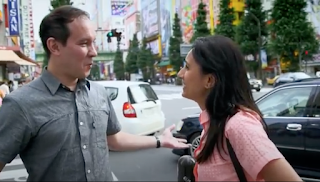Distance and disaster

Hokusai's "Great Wave off Kanagawa," 1833
I was in Oregon when the quake and wave first struck Japan last month. More specifically, I was in a little comfort food eatery called Belly in downtown Eugene, sipping a martini. Roughly 24 hours earlier I had arrived from Tokyo via Portland.
I had given two talks, answered questions, and chatted with students and faculty from the university that day, mostly about my usual topics: Japan’s contemporary popular culture, its images, and its apocalyptic visual narratives.
I was speaking on the 66th anniversary of the US fire-bombings of Tokyo, March 10, 1945. My Japanese mother's father hustled her and the rest of their family north out of Tokyo to his family's ancestral home in Esashi, Iwate prefecture, the following day. If he hadn't, I might not be here.
Discussing destruction seemed apt. Japanese popular culture has long depicted disasters, I’d said, from Katsuhika Hokusai’s world-renowned “Great Wave off Kanagawa,” an ukiyo-e print depicting a tsunami, to Godzilla films in the 1950s and now-classic anime features like Akira, Evangelion and Grave of the Fireflies. Even Hayao Miyazaki’s last film, Ponyo, animated the destructive powers of a tsunami in a small seaside village.
The audience nodded, took notes, smiled appreciatively. As usual when I’m speaking to Americans in the US, the Japan I know and inhabit felt both curiously intimate and terribly far away.

Oregon coast, 2011
For over a decade, I have been traveling between two cities in two countries, both of which have come to feel like ‘homes’ to me, certainly more than any other towns or nations in the world. Family and friends are at both ends of that journey, and they are all dear to me. I have had some kind of residence in New York since 1991; since 2000, the same has been true of Tokyo. What started as a nervy, sometimes jarring or exhilarating experience—exchanging one country and culture for another, adapting on the fly to different cultural expectations and behaviors, refraining from bowing in NYC, restraining my wayward American gait in Tokyo—hasn’t exactly become commonplace, but neither does it feel quite as glamorous or disruptive as it once did.
But when I’m arriving in a city in which I don’t live, the disjunctions of jet lag are sharpened, and a sense of detachment is an almost willful gesture, a way of retreating into the shell of the self to observe the new world, its contours and shapes and signage.
I was in that state, that frame of suspended mental pauses between scenes, when I got the news about Japan. I immediately went online, clicking from site to site, sending emails pinging across the Pacific and around the US. The great tsunami wave sweeping and then oozing across farmland, sucking down houses and trees, ships and automobiles, was probably the apotheosis of apocalyptic imagery, at least as divined by the natural world.
After it became clear that my family and friends were okay—or not okay, not even well, but unharmed physically—I tried to get on with work and life in Oregon, and during subsequent trips to Los Angeles, New York, Baltimore and DC. Living and working in two countries with disparate time zones means that two clocks tick in your brain. At midnight in one, the color of the sky in the other at midday spools like film through your mind. You start to feel like you’re here and there simultaneously, working to meet a deadline as the afternoon sky dims in your here here, because you know that morning in your there there is fast approaching. And if you don’t finish on time, no matter where you are, you’ll be late.
But it’s a delusion, of course—silly wabbit, tricks are for kids, as the old American cereal commercial said. You’re never there when you’re here. The desire to bridge distances and differences via art and language, stories, music and cuisine, embodies the pathos of impossibility. And the technologies we have devised, the supersonic jets, the emails and web cams and Skype calls, are belittled in an instant by the stone physicality of the world. When something happens over there, something transformative and overwhelming, it didn’t happen to you here.
I am back on the road again, presenting on Japan’s popular culture in New York and soon in Seattle. This week, I’m in London. During my talks, Hokusai’s “Great Wave” flashes upon the projection screens above and behind me. It looks more menacing now, of course, and suddenly pertinent.
But at night in my hotel rooms, I sit in front of smaller screens, clicking through updates and real-time TV streams, absorbed in tracking time through information, feeling stuck and very local: thrust roughly by disaster back into my only home—organs, skin, blood and bones—rendered bereft by distance, and yearning so hard in times of heartache to bridge it.

.jpg)